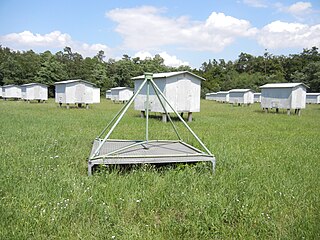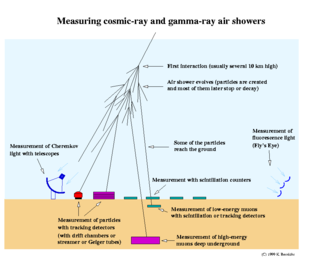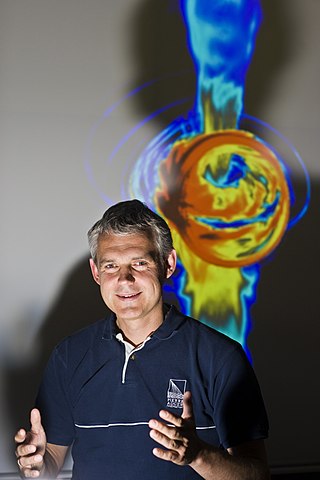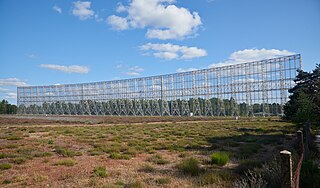
The Square Kilometre Array (SKA) is an intergovernmental international radio telescope project being built in Australia (low-frequency) and South Africa (mid-frequency). The combining infrastructure, the Square Kilometre Array Observatory (SKAO), and headquarters, are located at the Jodrell Bank Observatory in the United Kingdom. The SKA cores are being built in the southern hemisphere, where the view of the Milky Way galaxy is the best and radio interference is at its least.

Birr Castle is a large castle in the town of Birr in County Offaly, Ireland. It is the home of the 7th Earl of Rosse and his family, and as the castle is generally not open to the public, though the grounds and gardens of the demesne are publicly accessible, and include a science museum and a café, a reflecting telescope which was the largest in the world for decades and a modern radio telescope.

Onsala Space Observatory (OSO), the Swedish National Facility for Radio Astronomy, provides scientists with equipment to study the Earth and the rest of the Universe. The observatory operates two radio telescopes in Onsala, 45 km south of Gothenburg, and takes part in several international projects. Examples of activities:

The Low-Frequency Array (LOFAR) is a large radio telescope, with an antenna network located mainly in the Netherlands, and spreading across 7 other European countries as of 2019. Originally designed and built by ASTRON, the Netherlands Institute for Radio Astronomy, it was first opened by Queen Beatrix of The Netherlands in 2010, and has since been operated on behalf of the International LOFAR Telescope (ILT) partnership by ASTRON.

Owens Valley Radio Observatory (OVRO) is a radio astronomy observatory located near Big Pine, California (US) in Owens Valley. It lies east of the Sierra Nevada, approximately 350 kilometers (220 mi) north of Los Angeles and 20 kilometers (12 mi) southeast of Bishop. It was established in 1956, and is owned and operated by the California Institute of Technology (Caltech). The Owens Valley Solar Array portion of the observatory has been operated by New Jersey Institute of Technology (NJIT) since 1997.

South African Astronomical Observatory (SAAO) is the national centre for optical and infrared astronomy in South Africa. It was established in 1972. The observatory is run by the National Research Foundation of South Africa. The facility's function is to conduct research in astronomy and astrophysics. The primary telescopes are located in Sutherland, which is 370 kilometres (230 mi) from Observatory, Cape Town, where the headquarters is located.

The LOPES project was a cosmic ray detector array, located in Karlsruhe, Germany, and is operated in coincidence with an existing, well calibrated air shower experiment called KASCADE. In 2013, after approximately 10 years of measurements, LOPES was finally switched off and dismantled.

Leviathan of Parsonstown, or Rosse six-foot telescope, is a historic reflecting telescope of 72 inches (1.83 m) aperture, which was the largest telescope in the world from 1845 until the construction of the 100-inch (2.5 m) Hooker Telescope in California in 1917. The Rosse six-foot telescope was built by William Parsons, 3rd Earl of Rosse on his estate, Birr Castle, at Parsonstown in Ireland.

ASTRON is the Netherlands Institute for Radio Astronomy. Its main office is in Dwingeloo in the Dwingelderveld National Park in the province of Drenthe. ASTRON is part of the institutes organization of the Dutch Research Council (NWO).

Llano de Chajnantor Observatory is the name for a group of astronomical observatories located at an altitude of over 4,800 m (15,700 ft) in the Atacama Desert of northern Chile. The site is in the Antofagasta Region approximately 50 kilometres (31 mi) east of the town of San Pedro de Atacama. The exceptionally arid climate of the area is inhospitable to humans, but creates an excellent location for millimeter, submillimeter, and mid-infrared astronomy. This is because water vapour absorbs and attenuates submillimetre radiation. Llano de Chajnantor is home to the largest and most expensive astronomical telescope project in the world, the Atacama Large Millimeter Array (ALMA). Llano de Chajnantor and the surrounding area has been designated as the Chajnantor Science Reserve by the government of Chile.

An astronomical interferometer or telescope array is a set of separate telescopes, mirror segments, or radio telescope antennas that work together as a single telescope to provide higher resolution images of astronomical objects such as stars, nebulas and galaxies by means of interferometry. The advantage of this technique is that it can theoretically produce images with the angular resolution of a huge telescope with an aperture equal to the separation, called baseline, between the component telescopes. The main drawback is that it does not collect as much light as the complete instrument's mirror. Thus it is mainly useful for fine resolution of more luminous astronomical objects, such as close binary stars. Another drawback is that the maximum angular size of a detectable emission source is limited by the minimum gap between detectors in the collector array.

The Medicina Radio Observatory is an astronomical observatory located 30 km from Bologna, Italy. It is operated by the Institute for Radio Astronomy of the National Institute for Astrophysics (INAF) of the government of Italy.

A cosmic-ray observatory is a scientific installation built to detect high-energy-particles coming from space called cosmic rays. This typically includes photons, electrons, protons, and some heavier nuclei, as well as antimatter particles. About 90% of cosmic rays are protons, 9% are alpha particles, and the remaining ~1% are other particles.

The Australian Square Kilometre Array Pathfinder (ASKAP) is a radio telescope array located at Murchison Radio-astronomy Observatory (MRO) in the Mid West region of Western Australia.

Heino Falcke is a German professor of radio astronomy and astroparticle physics at the Radboud University Nijmegen (Netherlands). His main field of study is black holes, and he is the originator of the concept of the 'black hole shadow'. In 2019, Falcke announced the first Event Horizon Telescope results at the EHT Press Conference in Brussels.

The Nançay Radio Observatory, opened in 1956, is part of Paris Observatory, and also associated with the University of Orléans. It is located in the department of Cher in the Sologne region of France. The station consists of several instruments. Most iconic of these is the large decimetric radio telescope, which is one of the largest radio telescopes in the world. Long established are also the radio heliograph, a T-shaped array, and the decametric array operating at wavelengths between 3 m and 30 m.

Melanie Johnston-Hollitt is an Australian astrophysicist and professor. She has worked on the design, construction, and international governance of several radio telescopes including the Low Frequency Array (LOFAR), the Murchison Widefield Array (MWA) and the upcoming Square Kilometre Array (SKA). She was the director of the Murchison Widefield Array until December 2020 and is a professor at the Curtin Institute of Radio Astronomy at Curtin University and the International Centre for Radio Astronomy Research. Since August 2020, Melanie Johnston-Hollitt is the director of the Curtin Institute for Data Science.
Jamie S. Farnes is a British cosmologist, astrophysicist, and radio astronomer based at the University of Oxford. He studies dark energy, dark matter, cosmic magnetic fields, and the large-scale structure of the universe. In 2018, it was announced by Oxford that Farnes may have simultaneously solved both the dark energy and dark matter problems, using a new negative mass dark fluid toy model that "brings balance to the universe".

PSR J0952–0607 is a massive millisecond pulsar in a binary system, located between 3,200–5,700 light-years (970–1,740 pc) from Earth in the constellation Sextans. It holds the record for being the most massive neutron star known as of 2022, with a mass 2.35±0.17 times that of the Sun—potentially close to the Tolman–Oppenheimer–Volkoff mass upper limit for neutron stars. The pulsar rotates at a frequency of 707 Hz, making it the second-fastest-spinning pulsar known, and the fastest-spinning pulsar known within the Milky Way.
Lorun is a village in Ardabil province, Iran.

















